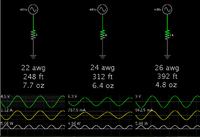ChrisHansen2Legit2Quit
Member level 2

Dear friends,
I understand the principle of induction.
I understand how a mechanical wave (sound) is converted (via mic) into an electrical signal & thus turned back (via loudspeaker) into mechanical wave (sound).
I understand all the rules that follow (Fleming, Lenz, etc).
I have made many loudspeakers before, though I have always guessed on the magnet & voice coil. I literally just grabbed any magnet I could find & wrapped as many turns of wire around it as possible. Not enough turns & the speaker wouldn't function. Too many turns & my cone literally sagged down on the suspension/spider & it wouldn't function. There was no math involved, lol.
I assume there is a proper way to do this. Perhaps a function?
Additional,
The amplifier I will be using puts out 20wrms/ch. @ 4 ohms. It will run up to 16 ohm. I assume I need to match the impedance of the speaker with that of the amplifier. Not sure how though.
I know it's a bit unconventional, but I will be winding the voice coil around the magnet. This is for a presentation & I want the vc to be visible! (not hiding inside the ring magnet)
I will be ordering from this company: https://www.kjmagnetics.com/products.asp?cat=13
The link brings you directly to the cylindrical neo magnets. I wish to use these. My budget is $10/magnet.
Any tips for winding the voice coil? I assume the goal here is getting as much copper within the lines of flux as possible. Is it okay to "overlap" turns? Is there a convention as far as which way to mount the magnet? For instance, the N pole should always be facing down. I assume this doesn't matter as I could just as easily switch the polarity of the voice coil.
Thoughts?
I understand the principle of induction.
I understand how a mechanical wave (sound) is converted (via mic) into an electrical signal & thus turned back (via loudspeaker) into mechanical wave (sound).
I understand all the rules that follow (Fleming, Lenz, etc).
I have made many loudspeakers before, though I have always guessed on the magnet & voice coil. I literally just grabbed any magnet I could find & wrapped as many turns of wire around it as possible. Not enough turns & the speaker wouldn't function. Too many turns & my cone literally sagged down on the suspension/spider & it wouldn't function. There was no math involved, lol.
I assume there is a proper way to do this. Perhaps a function?
Additional,
The amplifier I will be using puts out 20wrms/ch. @ 4 ohms. It will run up to 16 ohm. I assume I need to match the impedance of the speaker with that of the amplifier. Not sure how though.
I know it's a bit unconventional, but I will be winding the voice coil around the magnet. This is for a presentation & I want the vc to be visible! (not hiding inside the ring magnet)
I will be ordering from this company: https://www.kjmagnetics.com/products.asp?cat=13
The link brings you directly to the cylindrical neo magnets. I wish to use these. My budget is $10/magnet.
Any tips for winding the voice coil? I assume the goal here is getting as much copper within the lines of flux as possible. Is it okay to "overlap" turns? Is there a convention as far as which way to mount the magnet? For instance, the N pole should always be facing down. I assume this doesn't matter as I could just as easily switch the polarity of the voice coil.
Thoughts?


